Assignment on Sustainable Energy PDF
23 Pages6111 Words56 Views
Added on 2022-08-09
About This Document
i send two file assignment b its my fail reason in last time
Assignment on Sustainable Energy PDF
Added on 2022-08-09
ShareRelated Documents
Sustainable energy
Abstract:-
Abstract:-
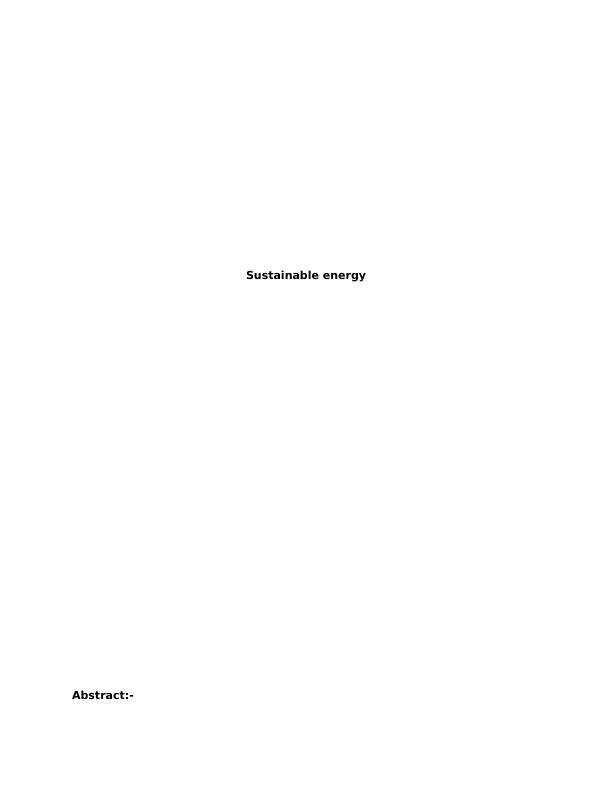
An integrated methodology of scenario has been proposed for the low
emission energy system in the context with the environment and social-economy by
using solar technology. By analyzing the demand in the all energy sector, the
methodology provides the best results by the use of solar technology for the ‘solar
energy for buildings’. The result of this technology shows that zero-carbon emission
will be attained in 2100. The U.K. is the third most solar power generator (Zhang,
Mclellan and Li, 2015). Stabilization of Climate change will bring the net carbon
emissions to zero. If the emission of carbon due to the climate change is equal to
the maximum acceptable limit that is near 20 Celsius, then the world economy will
decarbonize by 2100. This argues needed to act with open eyes on this border
situation. Countries should act on argue of climate change, by changing their
policies, technologies and investment patterns (Bergthorson, 2018). Government of
the U.K. set the ambitious target of reduction of greenhouse emission (carbon
emission) is 80% up-to 2050. Reduction of carbon can be achieved in future by use
of renewable energy resources. The U.K. government has taken steps to reduce the
emission of greenhouse gases through legally binding agreements, at present and
in the future. Various technologies can help to meet the target in the future by use
of secure energy. This research is related to the case study of the U.K. and
investigates the reduction measures to reduce energy consumption. These are the
widely available source and more convenient that can be stored as solar energy. In
this study, we use solar P.V. module of the hydrologic and cooling based system are
used recently that includes the solar roof installation of heat mat (active system). For future
development LZC (low and zero-carbon) Building Integrated Photovoltaic (BIPV)
design module technology is used for a high proportion in the U.K.
1. Introduction:-
Technologies such as nuclear, thermal and biomass are used for the
generation of electricity. Various technologies are shown for commercial, residential
industry and transportation sector. More and more heat is generated by the
nonrenewable resources that increase the carbon emission and effects the
environment at a great extent. Clean thermal power, hydrogen, biomass, and
nuclear provides zero carbon emission.
emission energy system in the context with the environment and social-economy by
using solar technology. By analyzing the demand in the all energy sector, the
methodology provides the best results by the use of solar technology for the ‘solar
energy for buildings’. The result of this technology shows that zero-carbon emission
will be attained in 2100. The U.K. is the third most solar power generator (Zhang,
Mclellan and Li, 2015). Stabilization of Climate change will bring the net carbon
emissions to zero. If the emission of carbon due to the climate change is equal to
the maximum acceptable limit that is near 20 Celsius, then the world economy will
decarbonize by 2100. This argues needed to act with open eyes on this border
situation. Countries should act on argue of climate change, by changing their
policies, technologies and investment patterns (Bergthorson, 2018). Government of
the U.K. set the ambitious target of reduction of greenhouse emission (carbon
emission) is 80% up-to 2050. Reduction of carbon can be achieved in future by use
of renewable energy resources. The U.K. government has taken steps to reduce the
emission of greenhouse gases through legally binding agreements, at present and
in the future. Various technologies can help to meet the target in the future by use
of secure energy. This research is related to the case study of the U.K. and
investigates the reduction measures to reduce energy consumption. These are the
widely available source and more convenient that can be stored as solar energy. In
this study, we use solar P.V. module of the hydrologic and cooling based system are
used recently that includes the solar roof installation of heat mat (active system). For future
development LZC (low and zero-carbon) Building Integrated Photovoltaic (BIPV)
design module technology is used for a high proportion in the U.K.
1. Introduction:-
Technologies such as nuclear, thermal and biomass are used for the
generation of electricity. Various technologies are shown for commercial, residential
industry and transportation sector. More and more heat is generated by the
nonrenewable resources that increase the carbon emission and effects the
environment at a great extent. Clean thermal power, hydrogen, biomass, and
nuclear provides zero carbon emission.
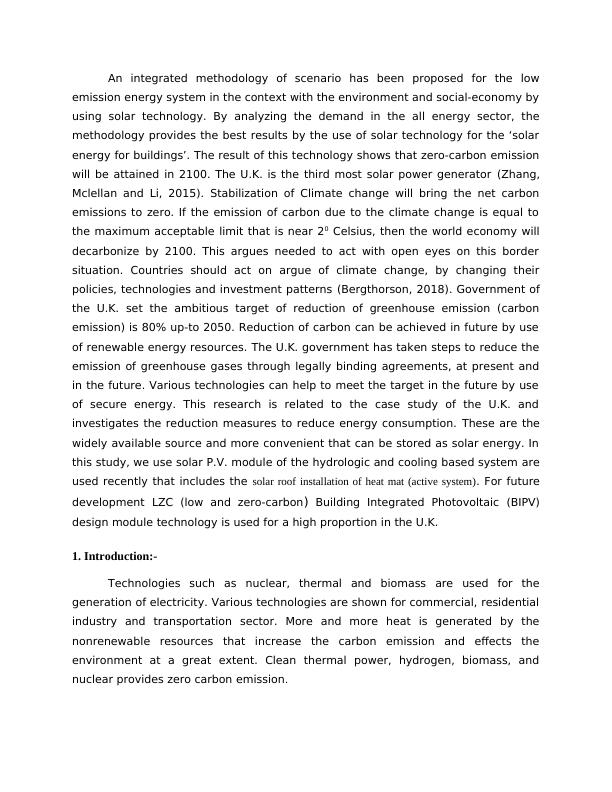
Figure 1. Various sectors emit CO2 (Zhang, Li and
Mclellan, 2014)
The expected electricity demand is around 1000TWh to keep the demand at
the same level from 2010 to 2100; all these sectors provides zero carbon emission
such that Zero Commercial CO2, Zero Biomass CO2, Zero Residential CO2, Zero
Transportation CO2, Zero Industry CO2
Figure 2:- Various sectors Energy Consumption
Mclellan, 2014)
The expected electricity demand is around 1000TWh to keep the demand at
the same level from 2010 to 2100; all these sectors provides zero carbon emission
such that Zero Commercial CO2, Zero Biomass CO2, Zero Residential CO2, Zero
Transportation CO2, Zero Industry CO2
Figure 2:- Various sectors Energy Consumption
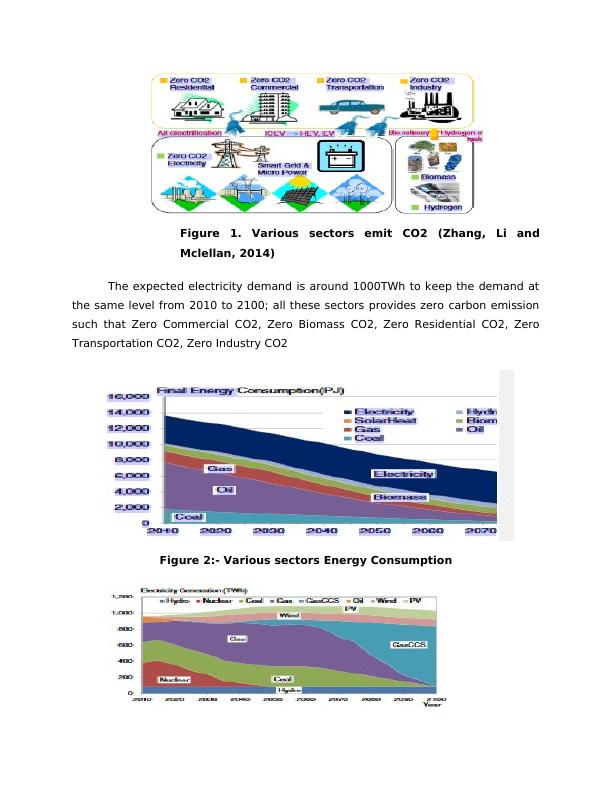
Figure3:- Electricity generation by renewable and nonrenewable energy
source (Zhang, Li and Mclellan, 2014)
From the graph, it shows that the U.K. produced around 6.5% of the
electricity from the renewable source in 2010. In 2011 it reached 9.6%.
Improvement on these technologies such as solar, wind and hydropower are
required to increase sustainability.
Fossil fuels are the convenient source of energy; its production cannot
increase the energy demand due to the large emission of carbon dioxide, which
affects climate. Resources of Low-carbon energy with high density are required to
replace these fossil fuels for the generation of thermal and electrical power (Zheng,
Yu and Tan, 2017).
The primary largest source of clean energy is the sun. While other sources of
energy such as biofuels, hydroelectric and fossil fuels are the secondary source of
energy. Earth receives in a year around 3 × 106 EJ of energy, that increase the
approximately 500 EJ of annual energy consumption for large-scale installations
(Bergthorson, 2018).
Figure 4:- Represent the estimation of Technology for future development
(Zhang, Li and Mclellan, 2014)
source (Zhang, Li and Mclellan, 2014)
From the graph, it shows that the U.K. produced around 6.5% of the
electricity from the renewable source in 2010. In 2011 it reached 9.6%.
Improvement on these technologies such as solar, wind and hydropower are
required to increase sustainability.
Fossil fuels are the convenient source of energy; its production cannot
increase the energy demand due to the large emission of carbon dioxide, which
affects climate. Resources of Low-carbon energy with high density are required to
replace these fossil fuels for the generation of thermal and electrical power (Zheng,
Yu and Tan, 2017).
The primary largest source of clean energy is the sun. While other sources of
energy such as biofuels, hydroelectric and fossil fuels are the secondary source of
energy. Earth receives in a year around 3 × 106 EJ of energy, that increase the
approximately 500 EJ of annual energy consumption for large-scale installations
(Bergthorson, 2018).
Figure 4:- Represent the estimation of Technology for future development
(Zhang, Li and Mclellan, 2014)
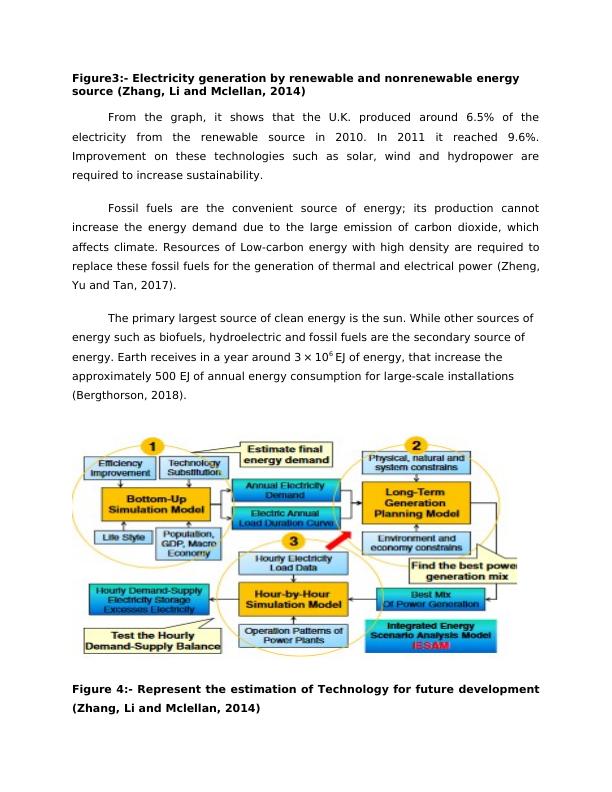
Efficiency measure by renewable energy systems, also called zero or low
carbon technologies. Due to higher power densities and the higher efficiencies of
large solar scale installation provides the benefit in the economic scale (Oliva et al.,
2015). To increase the generation of electricity from the clean solar energy, avoid
the generation associated with the other resources such as fossil fuels, biogas,
thermal power and nuclear power (Caird, Roy and Herring, 2008).
After surveying the influencing factors U.K. consumer adaption process can
be measured by the factors condensing boilers, loft insulation, energy-efficient
lighting and heating controls. Renewable energy such as solar photovoltaic and
solar thermal water heating provides high efficiency with high success rate. These
technologies are used to save money, energy, money and the environment (Masson
et al., 2014).
2. The current state of the technology:-
From the last few years the demand for solar energy is increasing because of
requirement of low carbon footprint. Currently, P.V. module is the most important
component of the solar system. This technology is very efficient nowadays for the
increases generated power of electricity. P.V. cell efficiency depends upon its
temperature. P.V. cell efficiency at average temperature remains in the range of 6%
to 15%. Power generation efficiency can be improved by the P.V. cells (Azzouz et
al., 2017). Two cooling methods are classified as a hydrologic and cooling based
system. Air P.V. cooling method related to the passive cooling. The hydraulic cooling
system is called hydraulic PV/T systems that are implementing by the water cooling,
liquid immersion cooling, heat pipe cooling and Phase change materials (PCM).
For ventilated facades in buildings, Air cooling has implemented. But in this heat
transfer from the P.V. is low when the temperature rises and become high up to
50oC. Other one PCM module is a beneficial system because of PCM materials. From
the PCM (Phase change materials) effectiveness of the energy, the module can achieve
by stabilizing the temperature of the P.V. cells. By using a PCM based cooling
system, approximately 6% efficiency can be increased as electrical output. These
systems at low temperature period store the cooling effect. In the presence of solar
carbon technologies. Due to higher power densities and the higher efficiencies of
large solar scale installation provides the benefit in the economic scale (Oliva et al.,
2015). To increase the generation of electricity from the clean solar energy, avoid
the generation associated with the other resources such as fossil fuels, biogas,
thermal power and nuclear power (Caird, Roy and Herring, 2008).
After surveying the influencing factors U.K. consumer adaption process can
be measured by the factors condensing boilers, loft insulation, energy-efficient
lighting and heating controls. Renewable energy such as solar photovoltaic and
solar thermal water heating provides high efficiency with high success rate. These
technologies are used to save money, energy, money and the environment (Masson
et al., 2014).
2. The current state of the technology:-
From the last few years the demand for solar energy is increasing because of
requirement of low carbon footprint. Currently, P.V. module is the most important
component of the solar system. This technology is very efficient nowadays for the
increases generated power of electricity. P.V. cell efficiency depends upon its
temperature. P.V. cell efficiency at average temperature remains in the range of 6%
to 15%. Power generation efficiency can be improved by the P.V. cells (Azzouz et
al., 2017). Two cooling methods are classified as a hydrologic and cooling based
system. Air P.V. cooling method related to the passive cooling. The hydraulic cooling
system is called hydraulic PV/T systems that are implementing by the water cooling,
liquid immersion cooling, heat pipe cooling and Phase change materials (PCM).
For ventilated facades in buildings, Air cooling has implemented. But in this heat
transfer from the P.V. is low when the temperature rises and become high up to
50oC. Other one PCM module is a beneficial system because of PCM materials. From
the PCM (Phase change materials) effectiveness of the energy, the module can achieve
by stabilizing the temperature of the P.V. cells. By using a PCM based cooling
system, approximately 6% efficiency can be increased as electrical output. These
systems at low temperature period store the cooling effect. In the presence of solar
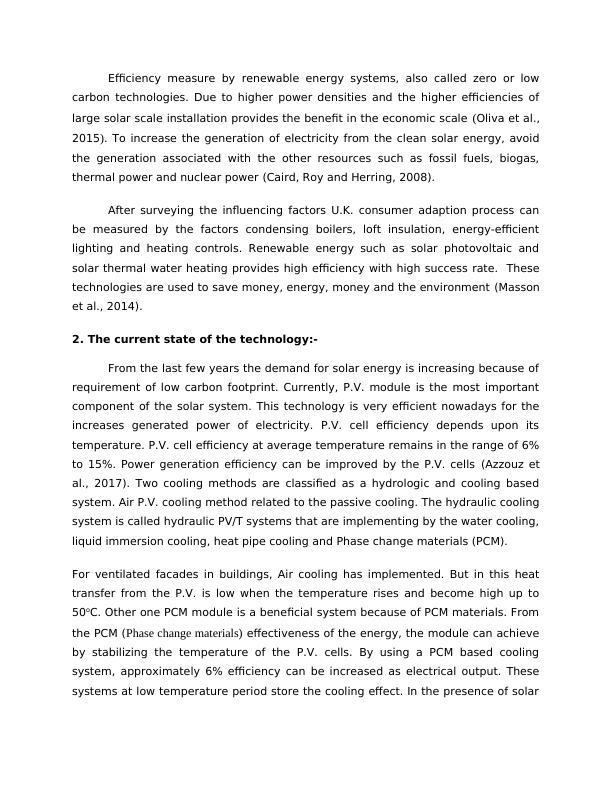
irradiance, the heat generated by the module of photovoltaic solar energy
harvesting not used by the P.V. (Xie et al., 2017).
The integration of the module of thermal and photovoltaic in the solar
irradiation built a system called Hybrid photovoltaic panels (PV/T). This integrated
system is enabled for the conversion of electrical and heat energies simultaneously
from the solar irradiation. To increase the electrical efficiency of the P.V. panel by
decrease, the temperature up-to 2050 and increase the efficiency of around 9%. In
water-based system, Utilization of the Nano-fluids provides the higher cooling
efficiency. In the colder climate, a special arrangement of heat pipes is required to
avoid the freezing condition of the water (Cooper et al., 2018).
Recently in the U.K., heat pipe technology is one of the most efficient
technology. These systems are not limited to the modular design, but also provides
the multiple contingencies (Jouhara et al., 2016). Parametric and Performance
analysis of the PV/T heat pipe system as a dynamic model has been presented.
From the previous research, it is analyzed and implemented in the solar building
design purpose; further performance of the system is increased. The solution is to
reduce the low carbon emission effectively in P.V. system and thermal system of
solar technology.
3. The technology used in the U.K.:-
Location:-The Cardiff, UK.
3.1Heat Mat (Flat heat pipe):-The heat mat is a flat multichannel heat pipe that is
used in U.K. PV/T flat heat mat converts the Building passive weather into an active
component that generates the heat and electricity. It is a unique design that allows
the efficient heat absorb which is collected by the surface facing the solar
irradiation. Heat is transferred above the surface of the heat pipe in which fluid is
flowing in the condenser section. To obtain the solar irradiation on whole surface
area manifold is attached to the back of the heat pipe. The heat mat used 100%
area of mat surface, which is facing towards solar irradiation (Jouhara et al., 2016).
harvesting not used by the P.V. (Xie et al., 2017).
The integration of the module of thermal and photovoltaic in the solar
irradiation built a system called Hybrid photovoltaic panels (PV/T). This integrated
system is enabled for the conversion of electrical and heat energies simultaneously
from the solar irradiation. To increase the electrical efficiency of the P.V. panel by
decrease, the temperature up-to 2050 and increase the efficiency of around 9%. In
water-based system, Utilization of the Nano-fluids provides the higher cooling
efficiency. In the colder climate, a special arrangement of heat pipes is required to
avoid the freezing condition of the water (Cooper et al., 2018).
Recently in the U.K., heat pipe technology is one of the most efficient
technology. These systems are not limited to the modular design, but also provides
the multiple contingencies (Jouhara et al., 2016). Parametric and Performance
analysis of the PV/T heat pipe system as a dynamic model has been presented.
From the previous research, it is analyzed and implemented in the solar building
design purpose; further performance of the system is increased. The solution is to
reduce the low carbon emission effectively in P.V. system and thermal system of
solar technology.
3. The technology used in the U.K.:-
Location:-The Cardiff, UK.
3.1Heat Mat (Flat heat pipe):-The heat mat is a flat multichannel heat pipe that is
used in U.K. PV/T flat heat mat converts the Building passive weather into an active
component that generates the heat and electricity. It is a unique design that allows
the efficient heat absorb which is collected by the surface facing the solar
irradiation. Heat is transferred above the surface of the heat pipe in which fluid is
flowing in the condenser section. To obtain the solar irradiation on whole surface
area manifold is attached to the back of the heat pipe. The heat mat used 100%
area of mat surface, which is facing towards solar irradiation (Jouhara et al., 2016).

End of preview
Want to access all the pages? Upload your documents or become a member.
Related Documents
Investigation of a Low/Zero Carbon Energy Technology using Solar Thermal for Buildingslg...
|14
|2915
|421
Energy and Waste Sustainabilitylg...
|10
|2316
|303
Renewable Energy Sources in Engineeringlg...
|9
|1718
|244
Sustainable Corporate Responsibility | Docslg...
|6
|749
|16
Carbon Tax is Best Solution for the Climate Changelg...
|6
|2016
|327
Nuclear Energy: Technology, Status, and Prospectslg...
|15
|2625
|80
